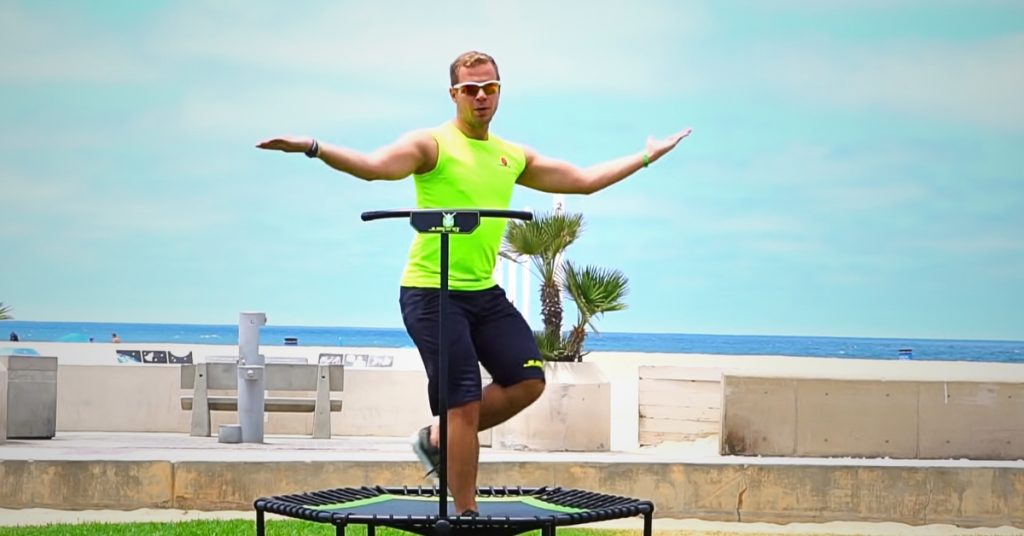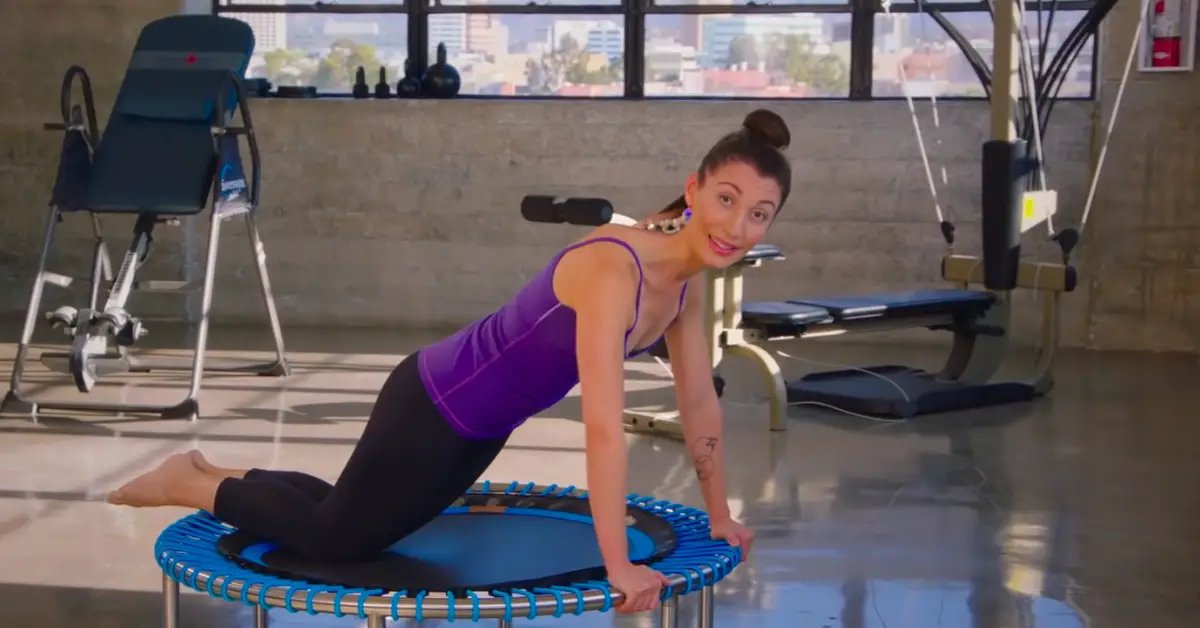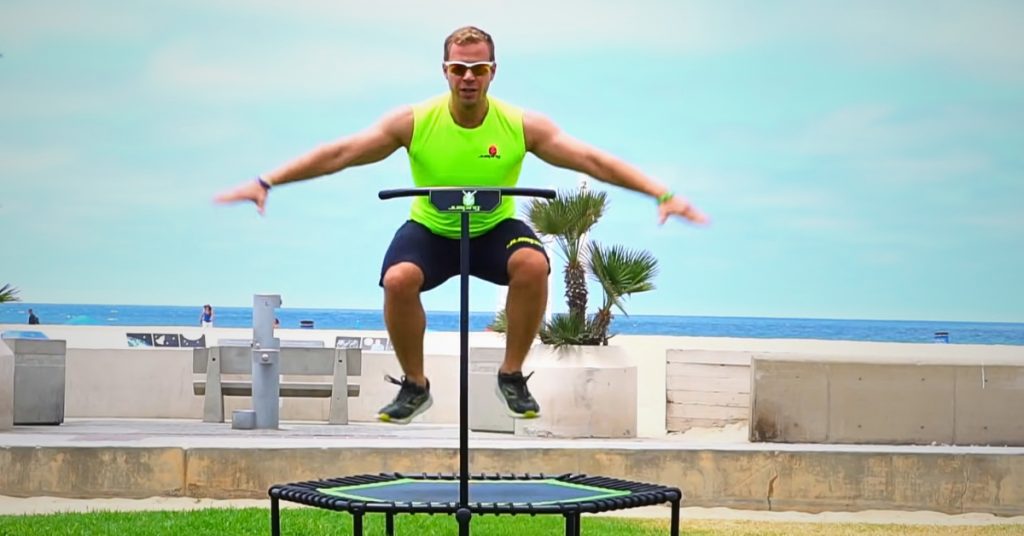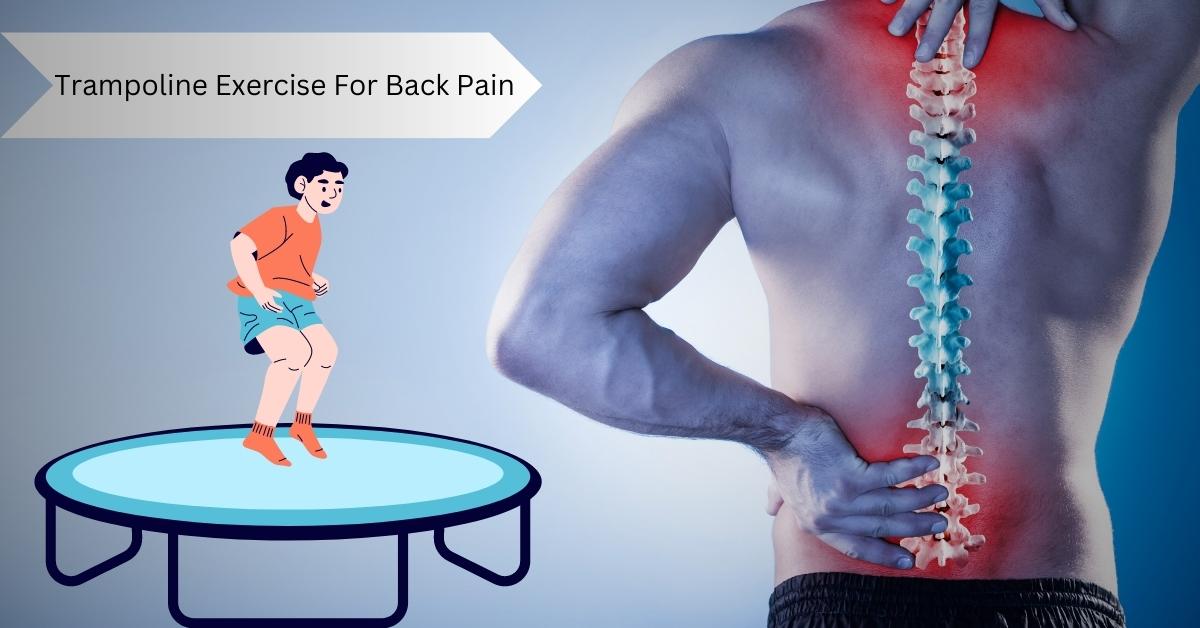Trampoline exercise has gained recognition as a potential solution for individuals suffering from back pain. This article explores the benefits of trampoline exercise in alleviating back pain and provides insights into the science behind its effectiveness.
Additionally, it offers guidance on proper warm-up techniques, low-impact exercises to strengthen core muscles supporting the back, and targeting specific areas of back pain through trampoline movements.
Safety precautions and tips for selecting an appropriate trampoline are also discussed. Moreover, this article delves into other health benefits of trampoline exercise beyond back pain relief.
Real-life success stories of individuals finding relief through trampoline exercise are shared, along with recommendations from physical therapists and fitness professionals regarding its use for back pain relief.
By understanding the potential benefits and incorporating trampoline exercise into their routine, individuals seeking relief from back pain can explore this alternative approach to regain mobility and improve their overall well-being.
Trampoline Exercise For Back Pain: Trampoline exercise can be a beneficial solution for individuals experiencing back pain. The low-impact nature of bouncing on a trampoline can help relieve pressure on the spine, improve circulation, and strengthen the muscles that support the back.
Understanding the Benefits of Trampoline Exercise for Back Pain

The potential benefits of incorporating trampoline exercise into a back pain management routine are worth considering due to the low-impact nature of this exercise and its ability to increase muscle strength and improve flexibility, which may contribute to alleviating back pain symptoms.
Trampoline exercise is a low-impact activity that reduces stress on the joints and spine, making it suitable for individuals with back pain. Using the trampoline’s mat as a cushion, it absorbs most of the impact the body would otherwise absorb. This promotes joint protection and minimizes strain on the back.
Proper form during trampoline exercise is crucial for optimizing its benefits in managing back pain. Maintaining proper alignment while jumping helps strengthen core muscles that support the spine, ultimately improving posture.
Engaging the abdominal muscles and maintaining a neutral spine position throughout each movement is essential.
Trampoline exercise can also enhance flexibility, another critical factor in managing back pain. Jumping on a trampoline requires stretching and contracting various muscle groups. These dynamic motions help improve overall flexibility, leading to an increased range of motion in daily activities.
Incorporating trampoline exercise into a back pain management routine can offer numerous benefits due to its low-impact nature and ability to increase muscle strength and flexibility.
Proper form during trampoline exercises ensures optimal results by improving posture through strengthening core muscles supporting the spine. Additionally, these exercises promote flexibility by engaging various muscle groups involved in dynamic movements.
Is it possible for a trampoline to cause back injuries?
Trampolines are a fun way to exercise, but they can also be risky. One of the common problems people face with trampolines is hurting their back. This usually happens when you land on the trampoline in the wrong way, which puts a lot of pressure on your back.
Although trampolines are made to be safe, there’s always a chance of getting hurt. If you’re worried about hurting your back while using a trampoline, it’s a good idea to talk to a doctor or another medical expert before using one.
The Science Behind How Trampoline Exercise Helps Alleviate Back Pain
One potential explanation for the positive effects of trampoline exercise on alleviating discomfort in the posterior region of the body lies in its ability to promote spinal decompression and improve overall musculoskeletal alignment.
Trampoline exercise involves a bouncing motion that creates a cyclical loading and unloading of forces on the spine. This rhythmic movement helps to stretch and elongate the intervertebral discs, which can relieve pressure on the nerves and reduce pain.
Furthermore, trampoline exercise also activates the core muscles, including the deep stabilizers of the spine. These muscles play a crucial role in maintaining proper posture and spinal alignment.
By strengthening these muscles, trampoline exercise helps to support the spine and distribute forces more evenly throughout the body.
In addition to promoting spinal decompression and improving musculoskeletal alignment, trampoline exercise also offers other benefits that may contribute to its effectiveness in alleviating back pain.
Regular jumping on a trampoline can improve cardiovascular fitness, increase bone density, and enhance overall flexibility.
However, it is essential to note that while trampoline exercise can benefit individuals with back pain, certain safety precautions should be followed. Using a high-quality trampoline with appropriate padding and spring tension is essential.
Additionally, individuals should start with low-impact exercises on the trampoline and gradually increase intensity as their strength improves.
Overall, understanding these underlying mechanisms and adhering to proper trampoline safety precautions can help individuals maximize the therapeutic benefits of trampoline exercise for back pain relief.
Proper Warm-Up and Stretching Techniques for a Safe Trampoline Workout

To ensure a safe and effective trampoline workout, it is crucial to incorporate proper warm-up and stretching techniques that adequately prepare the body for the activity.
Warm-up exercises are essential as they increase muscle blood flow, raise body temperature, and loosen up joints. This helps to reduce the risk of injury and enhances overall performance during the workout.
Some practical warm-up exercises before a trampoline session include light jogging or jumping jacks, which help elevate heart rate and warm up major muscle groups.
Stretching techniques are equally important in preparing the body for trampoline exercise. Static stretching, where a stretch is held for 15-30 seconds without bouncing or movement, can be performed for major muscle groups like hamstrings, quadriceps, and calves.
Dynamic stretching involves controlled movements that mimic specific actions required during trampolining. Examples of dynamic stretches include leg swings and arm circles.
In addition to these warm-up exercises and stretching techniques, gradually increasing intensity levels during the trampoline workout is essential. Starting with low-intensity jumps and gradually increasing height and complexity can help prevent sudden strain on muscles or joints.
Incorporating proper warm-up exercises and stretching techniques into your trampoline routine can minimize the risk of injury while maximizing performance potential.
Low-Impact Trampoline Exercises to Strengthen the Core Muscles Supporting the Back

Low-impact trampoline exercises have been shown to effectively strengthen the core muscles that support the spine’s stability. Trampoline workouts offer a unique and engaging way to engage these muscles without placing excessive strain on the back.
The controlled bouncing motion of trampolining activates the deep, stabilizing muscles in the abdomen and lower back, helping to improve overall spinal stability.
One key benefit of trampoline exercises for core strengthening is their low-impact nature. Unlike other forms of exercise, such as running or jumping on hard surfaces, trampolining provides a cushioned surface that absorbs shock and reduces stress on joints.
This is particularly important for individuals with back pain or recovering from injuries.
Additionally, trampoline workouts engage multiple muscle groups simultaneously, including the abdominals, obliques, and erector spinal muscles. These exercises improve posture and spinal alignment by improving muscle balance and coordination.
Strengthening these core muscles can also help alleviate back pain by providing more significant support to the spine during movement.
To maximize the benefits of trampoline exercises for core strengthening, it is essential to perform a variety of movements that target different muscle groups.
This includes tuck jumps, knee lifts, plank bounces, and side-to-side jumps. Regularly practicing these low-impact trampoline exercises can improve core strength and stability while minimizing strain on the back.
Targeting Specific Areas of Back Pain with Trampoline Movements
Targeting specific areas of discomfort in the back can be achieved through the strategic implementation of tailored trampoline movements. Trampoline exercise techniques offer a low-impact and effective way to strengthen the core muscles supporting the back, alleviating pain, and preventing future injuries.
Individuals can focus on strengthening specific muscle groups contributing to their back pain by engaging in targeted movements on the trampoline.
To effectively target different areas of back pain, it is essential to understand which muscles are involved and select appropriate trampoline exercises accordingly. The table below provides examples of trampoline movements that specifically target common areas of back discomfort:
| Area of Back Pain | Targeted Muscle Group | Trampoline Exercise |
|---|---|---|
| Lower Back | Erector Spinae | Jumping Jacks |
| Upper Back | Rhomboids | Arm Circles |
| Neck | Trapezius Muscles | Bounce and Stretch |
Incorporating these targeted exercises into a regular trampoline workout routine can help strengthen the muscles surrounding the affected area, improving stability and reducing pain.
Additionally, by focusing on proper form and technique during these movements, individuals can prevent further strain or injury to their back.
Incorporating specific trampoline exercise techniques into one’s fitness regimen can effectively prevent and manage back pain. By targeting specific muscle groups through tailored movements, individuals can address areas of discomfort while promoting overall strength and flexibility in their backs.
What are some tips to avoid back injuries while jumping on a trampoline?
Jumping on a trampoline is a lot of fun and good exercise, but it can hurt your back if you’re not careful. The important thing is to land properly when you jump.
When you jump, use your legs to push off and keep your back straight. Bend your knees when you land and try to land in the middle of the trampoline. If you land too close to the edge, you’re more likely to hurt your back.
With practice, you’ll get better at landing correctly and enjoy the trampoline without hurting your back. Here are some tips to remember: warm up before jumping, land in the center of the trampoline, and if your back starts to hurt, take a break and rest.
Incorporating Trampoline Exercise into Your Fitness Routine for Long-Term Back Pain Relief
Incorporating trampoline movements into one’s fitness routine can provide long-term relief for individuals experiencing chronic discomfort in their back. When incorporating trampoline exercise into a daily routine, it is essential to take certain precautions to ensure safety and maximize the benefits.
First and foremost, it is crucial to consult with a healthcare professional or physical therapist before starting any new exercise regimen, especially if one has pre-existing back conditions or injuries.
Once given the green light by a medical professional, starting slowly and gradually increasing the intensity and duration of trampoline exercises is recommended. This allows the body to adapt and build strength without excessive stress on the back muscles and joints.
Maintaining proper form throughout each movement is also essential, focusing on engaging the core muscles for stability and support.
Setting aside dedicated time for these exercises is essential to incorporate trampoline exercise into a daily routine effectively. Consistency is key when aiming for long-term relief from back pain. One can consider allocating at least 20-30 minutes daily solely for trampoline exercises or integrating them into an existing workout routine.
Incorporating trampoline movements into one’s fitness routine can effectively manage chronic back pain in the long term. However, individuals should prioritize safety by consulting with professionals, starting slowly, maintaining proper form, and dedicating regular time to these exercises.
By following these precautions and guidelines, individuals can reap the benefits of trampoline exercise while minimizing potential risks.
Tips for Choosing the Right Trampoline and Safety Precautions to Consider
When selecting a suitable trampoline and considering safety measures, it is essential to carefully evaluate the equipment’s quality and durability. Trampolines vary in size, shape, and materials, so choosing one that meets your needs is crucial.
Here are some tips to keep in mind when buying a trampoline:
- Size: Consider the available space in your home or yard before purchasing a trampoline. Measure the area where you place it to ensure it fits properly.
- Safety features: Look for trampolines with safety enclosures or nets that prevent users from falling off the jumping surface. Additionally, check for padded springs and frames to minimize the risk of injury.
- Weight capacity: Determine the trampoline’s limit to accommodate all potential users safely.
When using a trampoline for back pain relief, there are also essential safety precautions to consider:
- Warm-up exercises: Before starting any trampoline workout, perform gentle warm-up exercises to prepare your body for physical activity.
- Proper technique: Jumping on a trampoline with good form can help alleviate back pain and reduce the risk of injury. Land softly on your feet and engage your core muscles during each jump.
- Gradual progression: Start with low-impact jumps and gradually increase intensity as your back becomes more robust and flexible.
By following these guidelines, you can select a safe and suitable trampoline that will aid in relieving back pain while minimizing the risk of further injury or discomfort.
Other Health Benefits of Trampoline Exercise Beyond Back Pain Relief

One notable advantage of trampoline activities is the potential for improved physical fitness and cardiovascular health. Trampoline exercise offers various other health benefits beyond back pain relief.
Regular trampoline workouts can help individuals enhance their cardiovascular endurance, as it involves continuous jumping and bouncing movements that elevate heart rate and increase blood flow throughout the body.
This aerobic activity promotes a stronger heart, improved lung function, and enhanced circulation.
Additionally, trampolining can contribute to weight management and body toning. Jumping on a trampoline repetitively engages multiple muscle groups, including the legs, core, and arms. These movements not only strengthen muscles but also assist in burning calories and reducing body fat percentage.
Moreover, trampoline exercise aids in improving coordination, balance, agility, and flexibility due to the constant adjustments required to maintain stability while jumping.
Furthermore, engaging in regular trampolining sessions can be a great stress reliever. Jumping on a trampoline releases endorphins, the feel-good hormones which help alleviate anxiety and promote mental well-being.
It provides an enjoyable form of exercise that allows individuals to have fun while reaping numerous health benefits.
Beyond providing relief from back pain, trampoline exercise offers various other health advantages such as improved cardiovascular fitness, weight management capabilities, enhanced coordination and flexibility skills, along with stress reduction properties.
Incorporating this activity into one’s routine efficiently improves physical fitness and contributes positively to overall well-being.
Success Stories: Real-Life Experiences of Individuals Who Found Relief from Back Pain through Trampoline Exercise
Numerous success stories have documented the experiences of individuals who have achieved significant relief from their chronic back discomfort through trampoline workouts. Personal testimonials provide valuable insights into how trampoline exercise has helped alleviate back pain and improve overall well-being.
Individuals who have incorporated trampoline exercise into their routine report reduced back pain symptoms. They highlight how regular bouncing on a trampoline has strengthened their core muscles, improved flexibility, and increased blood circulation to the spine, resulting in less discomfort and stiffness.
The low-impact nature of trampoline workouts also allows individuals with back pain to engage in physical activity without exacerbating their condition.
Moreover, these success stories emphasize the role of trampoline exercise in preventing future episodes of back pain. Participants mention consistently engaging in this exercise has developed stronger muscles around their spine, providing better support and stability.
This increased strength helps prevent further strain on the back and reduces the likelihood of experiencing future pain episodes.
Personal testimonials reveal how trampoline exercise can effectively manage and prevent back pain. These accounts inspire others suffering from similar issues to consider incorporating this enjoyable and beneficial workout into their routine as part of a comprehensive approach to improving overall spinal health.
Expert Advice: Recommendations from Physical Therapists and Fitness Professionals on Using Trampoline Exercise for Back Pain Relief
Expert advice from physical therapists and fitness professionals provides valuable recommendations on using trampoline workouts effectively to find relief from discomfort in the spine.
Trampoline exercise for rehabilitation is widely recognized as a beneficial approach for individuals suffering from back pain. These exercises help strengthen the core muscles, improve flexibility, and enhance posture, crucial in alleviating spinal discomfort.
Trampoline exercise for seniors with back pain is particularly advantageous due to its low-impact nature. As people age, their joints become more susceptible to injury, making high-impact activities risky. Trampolines provide a safer alternative by reducing joint stress while offering an efficient workout.
Physical therapists recommend starting with gentle bouncing exercises on the trampoline to warm up the body and increase blood flow to the affected area. Gradually progressing to more advanced movements, such as jumping jacks or squats, can further enhance strength and stability in the back muscles.
Fitness professionals emphasize the importance of proper form during trampoline exercises. Maintaining a neutral spine position and engaging the core muscles throughout each movement helps prevent strain on the back and reduces potential injuries.
Experts recommend trampoline exercise as an effective method for relieving back pain. Whether used for rehabilitation or by seniors with spinal discomfort, incorporating these exercises into a fitness routine can improve mobility, reduce pain levels, and overall better quality of life.
Related article: Causes of back pain
Frequently Asked Questions:
Q.1 Are there any age restrictions or limitations for using a trampoline for back pain relief?
There may be age restrictions or limitations for trampoline exercise as a form of back pain relief. It is advisable to consult with a healthcare professional to determine if it suits one’s age and specific condition.
Q.2 Can trampoline exercise worsen existing back pain or cause new injuries?
Trampoline exercise benefits include improved cardiovascular health, muscle strength, and coordination. However, precautions should be taken to avoid exacerbating back pain or causing new injuries. Proper technique and supervision are essential for safe trampoline use.
Q.3 How long should a trampoline exercise session be to alleviate back pain effectively?
The optimal duration of trampoline exercise to effectively alleviate back pain varies depending on individual factors. However, research suggests that consistent participation in trampoline exercise for at least 20-30 minutes per session can be beneficial for reducing back pain and improving overall well-being.
Q.4 Are there any specific exercises or movements on a trampoline that should be avoided for individuals with back pain?
Individuals with back pain should avoid specific trampoline exercises. These exercises include high jumps, flips, and twists, which can strain the spine excessively. Instead, focus on low-impact movements that promote flexibility and core strength to alleviate back pain.
Trampoline exercise has been shown to provide benefits for back pain relief due to its ability to reduce pressure on the spine and increase blood circulation in the muscles.
Q.5 Can trampoline exercise alone eliminate chronic back pain completely, or is it recommended to combine it with other forms of treatment or therapy?
Combining trampoline exercise with physical therapy can provide benefits for back pain relief. Trampoline exercise alone may not be enough to eliminate chronic back pain. In addition, trampoline exercise may help reduce the need for pain medication in individuals with chronic back pain.
Conclusion
In conclusion, trampoline exercise has been shown to be a beneficial and effective method for alleviating back pain. The low-impact nature of the workout helps strengthen the core muscles supporting the back, targeting specific areas of pain.
Proper warm-up and stretching techniques are essential for a safe trampoline workout. Additionally, choosing the right trampoline and following safety precautions is crucial. Beyond back pain relief, trampoline exercise offers numerous other health benefits.
Real-life success stories and expert recommendations further validate its effectiveness in relieving back pain.
After reading this extensive Trampoline Exercise for Back Pain guide, we trust that you will thoroughly understand the subject. If you have any queries, please don’t hesitate to comment below. Thank you for your attention.

